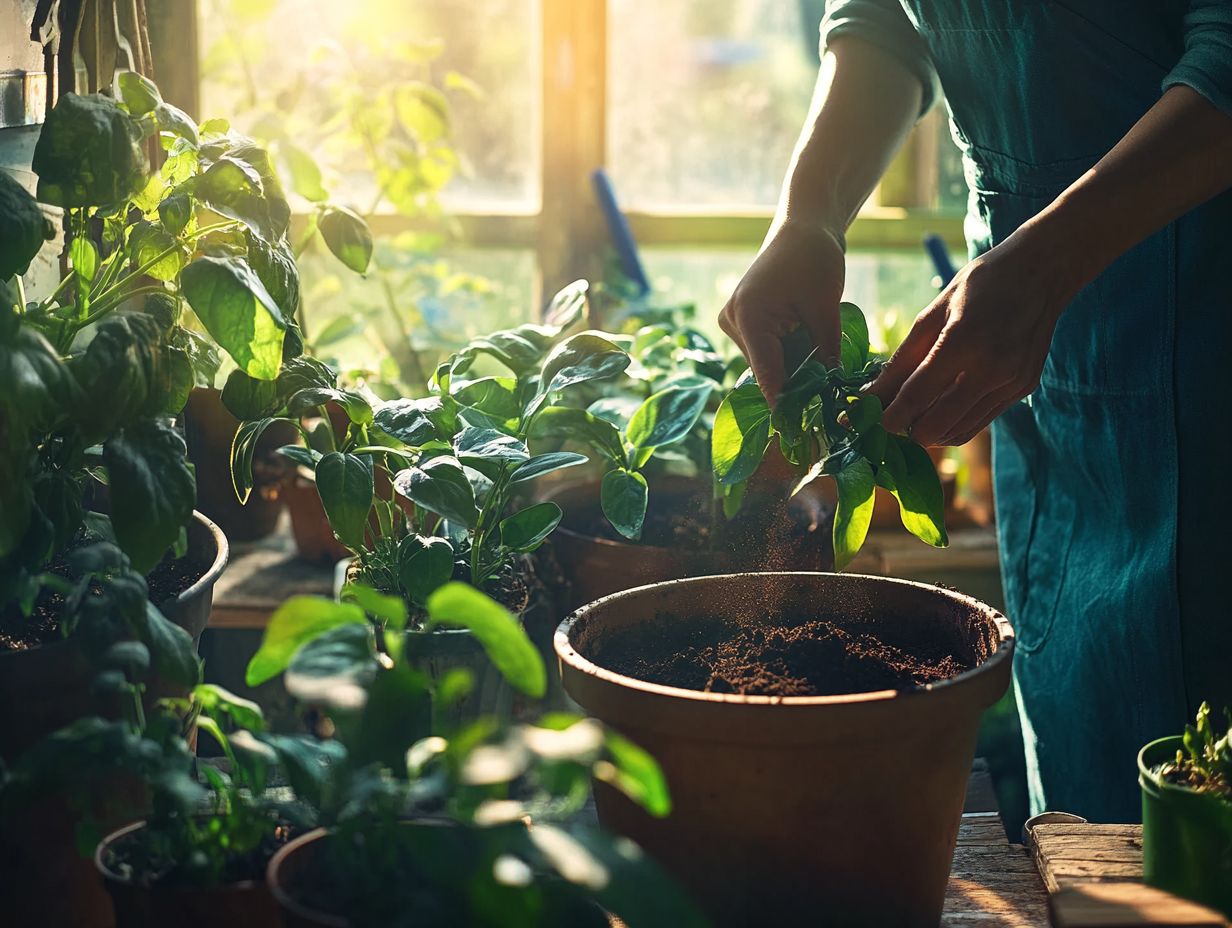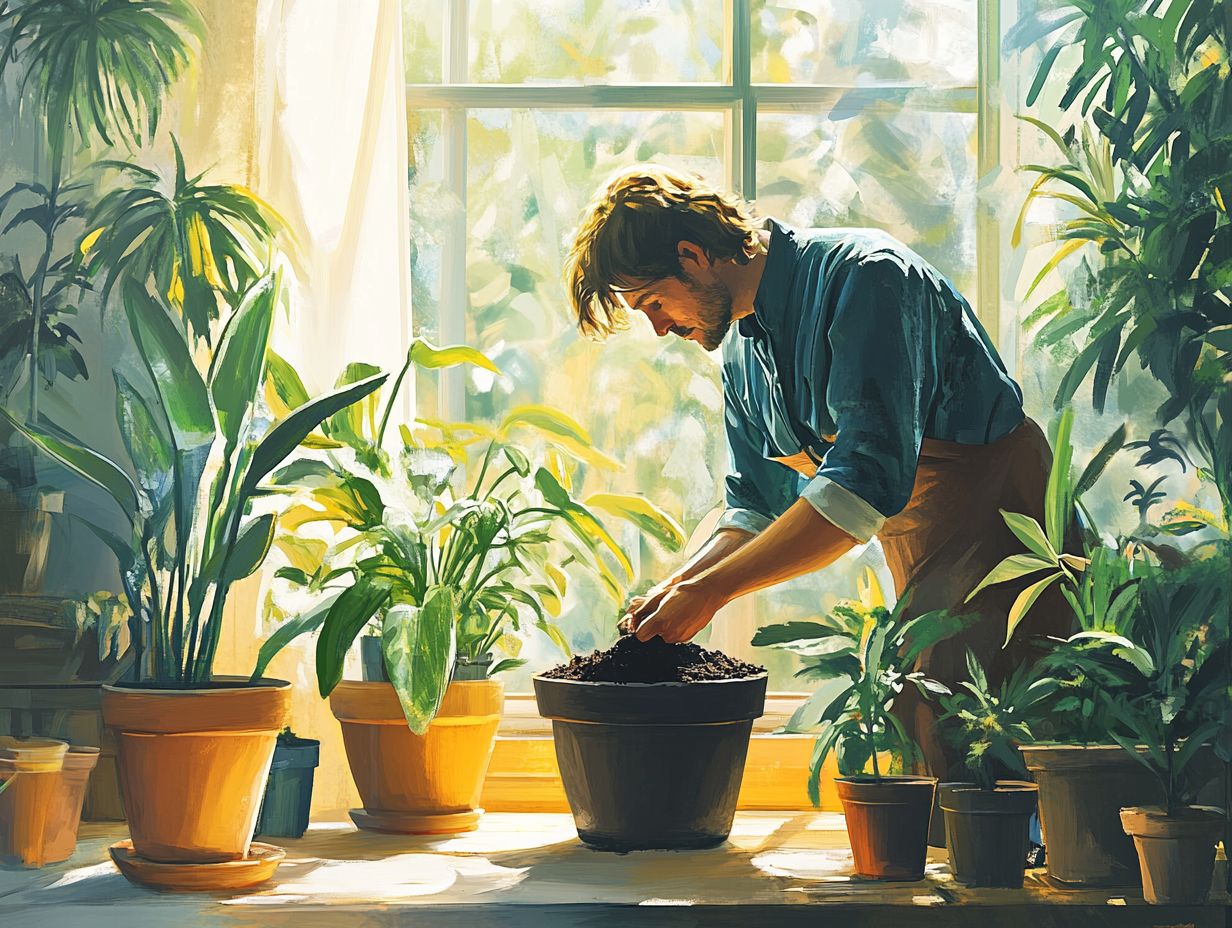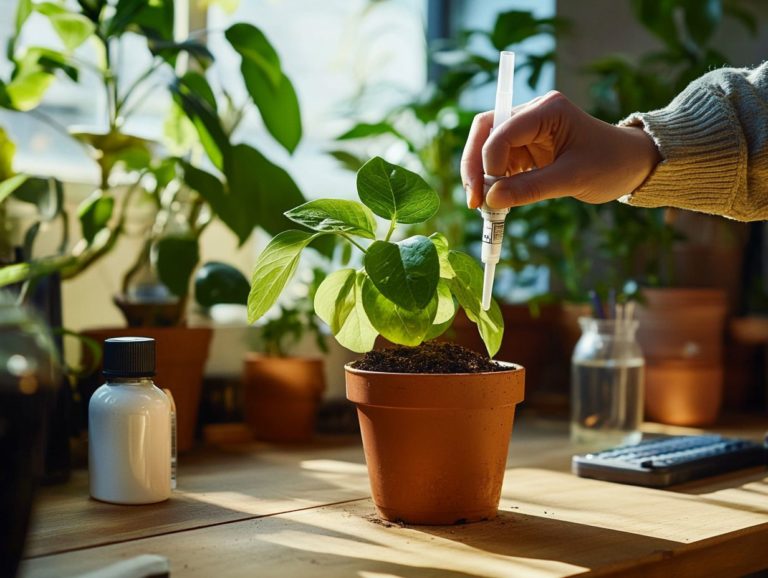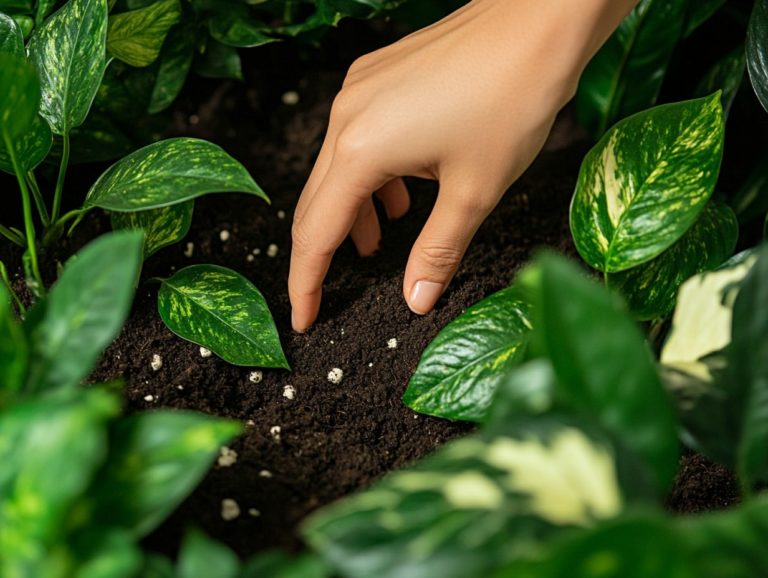How to Maintain Soil Health for Indoor Plants
Healthy soil serves as the cornerstone for flourishing indoor plants and successful gardening.
By grasping what constitutes healthy soil, identifying signs of its decline, and mastering maintenance techniques, you can greatly enhance your indoor gardening success and effectively care for houseplants.
This article delves into the essential elements of soil health, including effective watering methods, strategic nutrient additions, and the art of choosing the right soil for your indoor plants.
You ll also find valuable insights on drainage, aeration, and sustainable practices to ensure your indoor greenery and houseplants continue to thrive beautifully.
Contents
- Key Takeaways:
- Understanding Soil Health for Indoor Plants
- Signs of Poor Soil Health
- Identifying and Addressing Soil Issues
- Methods for Maintaining Soil Health
- Choosing the Right Soil for Indoor Plants
- Types of Soil and Their Benefits
- Additional Tips for Maintaining Soil Health
- Frequently Asked Questions
- What does it mean to maintain soil health for indoor plants?
- Why is it important to maintain soil health for indoor plants?
- What are some ways to maintain soil health for indoor plants?
- How often should I fertilize indoor plants to maintain soil health?
- Can I reuse soil to maintain soil health for indoor plants?
- What are some signs that my indoor plant’s soil needs maintenance?
Key Takeaways:

- Water your plants correctly and add necessary nutrients regularly.
- Select the right soil type and practice organic gardening.
- Check for signs of poor soil health and address issues quickly.
Understanding Soil Health for Indoor Plants
Understanding soil health is essential for successful gardening, especially when nurturing your indoor plants and caring for houseplants. Healthy soil not only supports vibrant houseplants but also improves moisture retention and nutrient availability.
Use ingredients like organic matter, peat moss, and perlite to create the best soil. Knowing the right soil composition allows you to maintain an efficient ecosystem that encourages the growth of houseplants such as spider plants, pothos, African violets, and strawberry begonias.
With the right soil, your houseplants won t just survive they ll thrive and enhance the overall health of your indoor environment.
What Makes Soil Healthy?
Healthy soil is essential for vibrant indoor plants. It provides essential nutrients, retains moisture, and supports beneficial organisms that foster growth.
These elements are crucial for your indoor greenery and overall soil quality. Achieving the right nutrient balance the right mix of vitamins and minerals that plants need is essential for promoting lush foliage and vibrant blooms in plants such as peace lilies and pothos.
Rich organic matter improves soil structure, facilitating better aeration and root penetration, crucial for propagating houseplants. This aspect is particularly important for delicate species like ferns, which flourish in well-drained environments.
Proper drainage prevents root rot, a common concern for plants like succulents. This ensures they receive the right amount of moisture without falling victim to waterlogging.
By understanding these essential components, you can craft an ideal growing medium tailored specifically to the needs of your plants, setting the stage for a flourishing indoor garden filled with healthy houseplants. Learning about the role of nutrients in indoor plant soil is crucial for achieving this goal.
Signs of Poor Soil Health
Look for signs of poor soil health to keep your plants thriving. Common indicators include wilting, yellowing leaves, and stunted growth, which often point to soil compaction or nutrient deficiencies affecting your houseplants.
Keep an eye out for these signs your plants are trying to tell you they need help! Issues related to drainage can worsen these problems, potentially leading to overwatering or inadequate moisture retention, ultimately jeopardizing the health of your beloved houseplants.
Identifying and Addressing Soil Issues
Identifying and addressing soil issues is crucial for your indoor plants. Healthy soil serves as the foundation for flourishing plants, impacting everything from how plants take in nutrients to moisture retention.
To kick off your soil assessment, consider using a simple soil test kit, often equipped with a pH meter or strips that reveal the acidity or alkalinity of your soil, aiding in the care of houseplants. For more detailed guidance, you can explore how to test soil quality for indoor plants. Check what’s in the soil by examining organic matter and watching for any deficiencies, which are typically signaled by yellowing leaves or stunted growth.
Signs that your soil might be unhealthy include a lack of earthworm activity, inadequate drainage, and crusty surfaces, which can all impact the moisture retention of your houseplants. To remedy these issues, you can enhance soil quality through composting, applying organic fertilizers, or even introducing cover crops, ensuring healthier soil and houseplants. Understanding the science of watering indoor plants will foster a robust environment that nurtures vibrant plant life, ensuring your indoor garden thrives.
Methods for Maintaining Soil Health

Maintaining soil health is essential for effective plant care, encompassing a blend of proper watering techniques, managing nutrients, and the incorporation of high-quality soil amendments while considering the water requirements of your plants. Choosing the right watering method can help you avoid overwatering, a common culprit in poor plant health.
By integrating organic materials like compost and mycelium, you can markedly enhance soil structure and nutrient availability, promoting healthier houseplants. To ensure proper hydration, it’s essential to learn how to water your indoor garden correctly. Regular assessments of soil quality will guide you on when to introduce fertilizers or other amendments, ensuring that your houseplants, such as bromeliads and philodendrons, thrive in a vibrant and healthy environment.
Proper Watering Techniques
Correct watering is key to keeping your plants thriving! Both overwatering and underwatering can lead to significant problems that you want to avoid.
Understanding the specific needs of each plant type is crucial for proper plant care. Some thrive in moist conditions, while others prefer a drier environment. To gauge moisture levels accurately, you can use simple tools like moisture meters or just stick your finger into the soil up to the second knuckle. If it feels dry, it’s time to water, avoiding common pitfalls like overwatering.
Equally important is ensuring adequate drainage, as stagnant water can suffocate roots and encourage root rot. The method of watering, whether from the top or bottom, also plays a critical role in how well nutrients are absorbed. Understanding soil pH for indoor plants impacts overall soil health and promotes robust growth in your houseplants. Striking the right balance benefits both your plants and their surroundings, creating a flourishing indoor garden.
Adding Nutrients and Amendments
Adding nutrients and amendments to your soil is essential for ensuring your indoor plants have access to the vital resources they need for growth.
One effective approach to enhancing soil quality is through organic amendments, such as compost and worm castings. Not only does this enrich the soil with crucial nutrients, but it also improves its structure, creating a healthier environment for root development. By incorporating compost, you can significantly boost microbial activity and nutrient availability, which in turn fosters robust plant growth and aids in the care of houseplants. Additionally, using the best organic fertilizers for indoor plants can provide valuable nutrients, along with materials like worm castings or well-rotted manure.
Remember, fertilizing your plants regularly will keep them healthy and happy! For example, using a slow-release organic fertilizer during the growing season can help replenish essential nutrients, ensuring your plants thrive and flourish throughout their lifecycle.
Choosing the Right Soil for Indoor Plants
Selecting the appropriate soil for your indoor plants is very important; it can significantly influence their growth and overall health.
Each plant has its own unique soil requirements, and understanding these nuances will enhance your gardening experience, especially when keeping houseplants healthy.
Types of Soil and Their Benefits
Various types of soil, such as potting mixes enriched with peat moss and perlite, offer distinct benefits that can significantly enhance the growth of your indoor plants.
Selecting the right soil type can transform your plants’ health and ability to thrive. For example, a well-aerated mix containing coconut coir, which is a natural fiber from coconut husks that helps retain moisture, is perfect for moisture retention while ensuring proper drainage ideal for tropical species that flourish in humid conditions. Incorporating the top soil amendments for healthy indoor plants can further enhance your plant care routine.
A heavy clay-based soil might be just what your succulents need, as it promotes excellent drainage. You can add organic matter like compost to enrich the substrate, supplying essential nutrients that support vibrant growth in your houseplants.
By understanding soil characteristics, you can immediately improve your plants health, including pruning and deadheading flowers, creating a flourishing indoor garden that thrives under your care.
Additional Tips for Maintaining Soil Health

Want your indoor plants to thrive? Maintaining soil health is a continuous journey that demands your attention and commitment. By implementing effective tips and practices, you can significantly enhance the quality of your soil, ensuring it remains vibrant and productive.
Proper Drainage and Aeration
Proper drainage and aeration are essential for maintaining optimal soil health. These elements ensure your indoor plants receive the oxygen they need while preventing waterlogging.
They are pivotal for moisture retention, directly impacting the health of the roots and the plants themselves. When your soil is well-drained yet retains some moisture, it creates an ideal environment for roots to efficiently absorb water and nutrients. On the flip side, poor drainage can lead to waterlogged conditions, suffocating roots and encouraging the growth of harmful fungi.
To achieve excellent drainage in your potting mixes, consider adding materials like perlite, a volcanic glass that improves aeration, or coarse sand; these will enhance airflow and prevent compaction. Using pots with drainage holes helps excess water escape, safeguarding your plants against stagnant moisture.
Using Organic and Sustainable Practices
Using organic and sustainable practices in your gardening not only enhances the vitality of your indoor plants but also positively contributes to environmental health.
These methods actively nurture your soil, creating a rich ecosystem of beneficial organisms essential for maintaining soil fertility. By incorporating compost and natural soil amendments, you can significantly boost nutrient availability and moisture retention.
This approach fosters robust plant growth and resilience. It also reduces your reliance on synthetic fertilizers and pesticides, minimizing harmful impacts on ecosystems.
Embracing such practices encourages biodiversity, making your garden more vibrant and productive over time. Ultimately, adopting organic gardening is a commitment to your personal well-being and the health of our planet.
Frequently Asked Questions
What does it mean to maintain soil health for indoor plants?
Maintaining soil health for indoor plants refers to ensuring that the soil in which your plants grow is rich in nutrients, has good drainage, and is free of any harmful chemicals or pests.
Why is it important to maintain soil health for indoor plants?

Soil health is crucial for the growth and overall health of your indoor plants. Healthy soil provides essential nutrients, supports root development, and allows for proper drainage, which all contribute to the vitality of your plants.
What are some ways to maintain soil health for indoor plants?
Some ways to maintain soil health include regularly checking soil moisture levels, fertilizing with organic materials, and using natural pest control methods. It’s also important to periodically repot your plants to ensure they have enough space and fresh soil to grow.
How often should I fertilize indoor plants to maintain soil health?
Fertilize indoor plants every 2 to 4 weeks during their growing season. Follow the specific instructions for each plant and fertilizer to avoid over-fertilization.
Can I reuse soil to maintain soil health for indoor plants?
It’s not a good idea to reuse soil for indoor plants. Always use fresh, clean soil for new plantings to give your plants the best chance to thrive!
What are some signs that my indoor plant’s soil needs maintenance?
Watch out for yellowing leaves or wilting! These can be red flags that your soil needs some love. Slow growth and excessive moisture or dryness are also signs to check the soil’s health.






